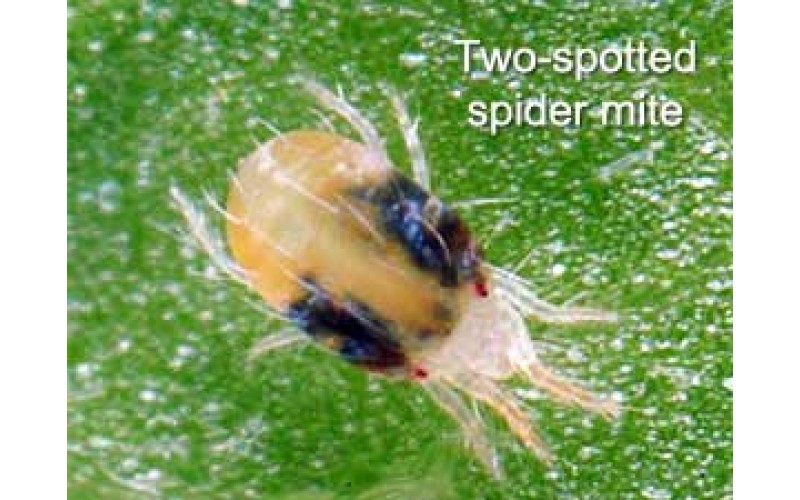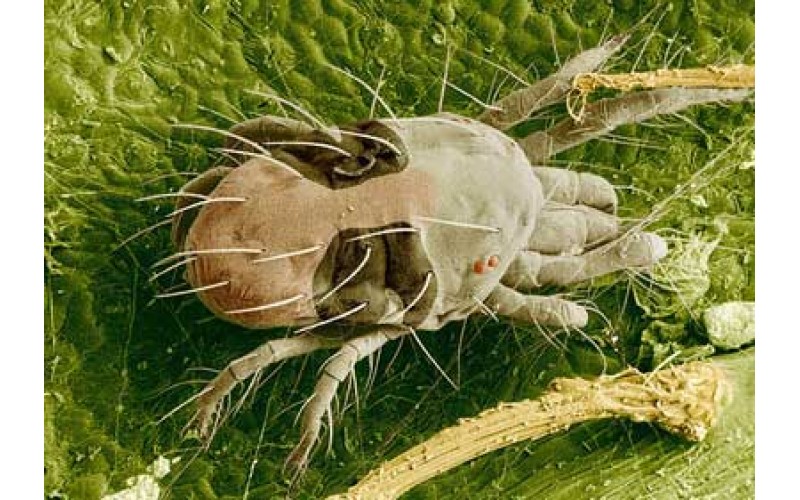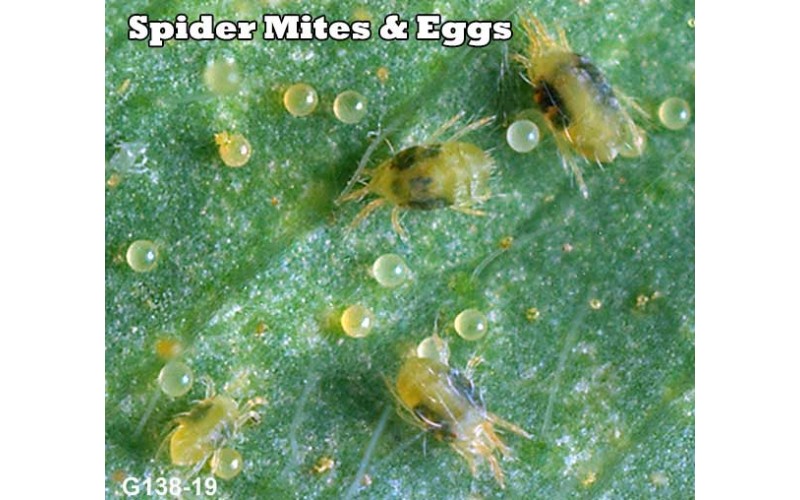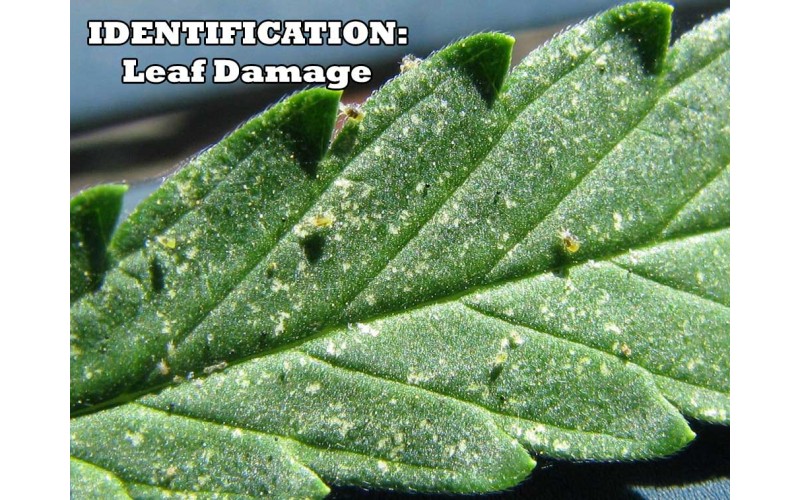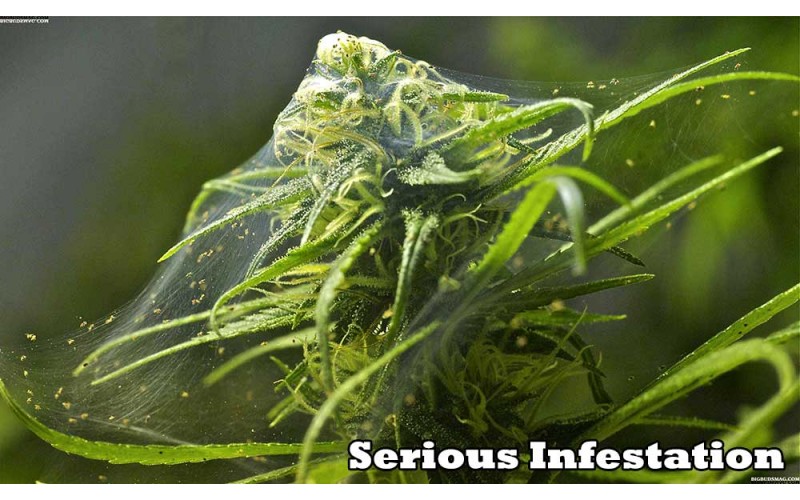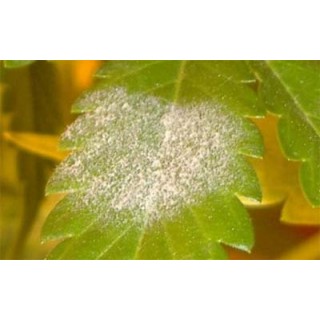Growroom Pests - Spider Mites
IDENTIFICATION
Spider mites are the 8-legged bane of marijuana growers. Mites are not insects, but arachnids, from the same family as spiders. If you have a spider mites, chances are it is the infamous two-spotted spider mite.
When looking through a loupe or magnifying glass, two black spots are visible on the pest’s back (SEE PIC). Spider mites are slightly smaller than a poppy seed. They feed by inserting a tube into the plant and sucking out its juices. Indoors, where they are not combating nature’s challenges, mites multiply quickly and overwhelm gardens.
Spider mite development differs somewhat between species, but a typical life cycle is as follows. The eggs are attached to fine silk webbing and hatch in approximately three days. The life cycle is composed of the egg, the larva, two nymphal stages (protonymph and deutonymph) and the adult. The length of time from egg to adult varies greatly depending on temperature. Under optimum conditions (approximately 80ºF), spider mites complete their development in five to twenty days. There are many overlapping generations per year. The adult female lives two to four weeks and is capable of laying several hundred eggs during her life.
DETECTION
Under low-infestation conditions, check the lowest & oldest growth on your plants first when searching for spider mites. Pluck a few of your lowest fan leaves and thoroughly inspect the underside of these leaves with a lighted loupe or microscope.
Spider mites are detectable with the naked eye, but a loupe or microscope greatly increases your chances of detection and identification. Although microscopes tend to be more powerful, a loupe tends to be a bit more user friendly. ( https://www.amazon.com/Growers-Edge-Illuminated-Magnifier-Loupe/dp/B005FV9MLC ).
Mites first inhabit the underside of the leaf and are not readily apparent in mild infestations. The first indication of their presence is usually tiny white asymmetrical damaged spots on the leaves (SEE PIC). These areas indicate sites where mites have used their proboscises to puncture the leaf surface and suck the plant’s sweet juices. As the population increases they are seen on the tops of leaves and they begin to build webs. Under extreme infestations, spider mites will literally “cocoon” your buds (SEE PIC).
TREATMENT
I always use preventative maintenance in vegetative growth stages. We spray our plants with a neem/soap solution whether there are pests present or not. The best treatment is prevention which insures our success in bloom stages.
I use Dyna-Gro Neem oil and have had success with neem for many years. Not only does it work, I feel great about using it. Most don’t even consider Neem a pesticide at all, but rather a “leaf polish”. It’s natural, safe, and I’ve seen it sold in health and homeopathic stores as creams, face washes and even dietary supplements. Dyna-Gro neem oil is what we use at The Healing Canna.
I’ll elaborate and breakdown our treatment process in a future blog.
(https://www.google.com/search?q=dyna+gro+neem+oil&biw=1240&bih=693&source=lnms&tbm=isch&sa=X&sqi=2&ved=0ahUKEwjvlszikqvSAhVH7mMKHcSVAFkQ_AUIBygC ).
Neem oil is a vegetable oil pressed from
the fruits and seeds of the neem (Azadirachta
indica), an evergreen
tree which is endemic
to the Indian
subcontinent and has been introduced to many other areas in the
tropics. It is the most important of the commercially available products of
neem for organic farming and medicines. Source: Wikipedia.
If your plants are still in a vegetative growth phase, you do have quite a few options.
You can wash them with a moderately vigorous spray to knock down the mite population. This will help the plants by lessening their loss of vital juices. Prepare a spray with a teaspoon of real soap such as Dr. Bronner’s peppermint or eucalyptus liquid soap per gallon of water, or spray with Safer’s horticultural soap to help dislodge and suffocate the pests. Mites are found on the underside of the leaves and must be sprayed there. If the plants are small or easy to handle it might be easier to dip them in the soapy water. Spraying can remove most but not all the mites, and it doesn’t remove the eggs.
A small mite infection left unchecked is a temporary condition. So it is unwise to go into flowering with infected plants. The problem is that after the plants are one third of the way through flowering, two to three weeks, you want to avoid spraying with water or soapy water to wash off the suckers.
Mites must be eliminated before flowering or they will multiply rapidly, sometimes with devastating results. The remaining harvest will be ravaged and tainted with sub-par skimpy buds which are covered in little mite carcasses. Certainly not the most desirable or flavorful end product.
An easier method for eradication is to use an acceptable miticide. There are several commercial miticides that can be used early in the season to kill mites.
Pyrethrum has been used to kill mites. It is a natural pesticide produced by a close relative of the chrysanthemum. The problem with using it is that many races of mites have developed immunity to it.
Cinnamite comes as a concentrate that is diluted and sprayed on the plants. It contains a miticide derived from cinnamon oil. It is very safe and is rated least hazardous. It is quite effective but it doesn’t kill the eggs. It should be used every three days for two weeks to make sure all the mites are killed soon after they hatch. It is a contact spray so plants should be dipped or sprayed on the leaf undersides. It is also effective against powdery mildew.
Avid is a miticide registered for ornamental plants. Its active ingredient is abamectin, a derivative of a toxin originally found in soil bacteria. Avid is not registered for use on vegetables except in certain restricted situations. Other brands of abamectin such as AgriMek by Syngenta are registered for a wide range of crops. The AgriMek label calls for a minimum of a seven day wait between application and harvest. I personally wouldn’t consume marijuana that was treated with this pesticide during the last few weeks of flowering.
Predators are another option. Predatory mites or other predators are an organic alternative. These carnivorous mites can minimize damage and control the pests if applied and used correctly.
PREVENTION
Ultimately, the solution to the mite problem and the pest problem in general is to prevent the garden from becoming infected in the first place. Implement and follow certain rules to prevent contamination.
1. The first rule and biggest chance of infestation is clones or plants from an outside source. Regardless of where I’ve obtained my genetics, I treat the newcomer(s) with neem, isolate the new kid on the block for at least two weeks, monitor the plant closely and then decide whether or not to integrate the plant into my mother population OR just take clones and dispose of the original plant along with her root-ball to lessen the chance of soil-born critters as well. Growers swear their plants are clean even when they’re not. Most growers are either too proud to admit they’re tainted or too “green” to realize they’ve actually got a problem.
2. Wear freshly washed clothes / shoes or change into a garden outfit when going into the garden, ESPECIALLY when coming from a garden which may have been infested.
3. Never work outdoors, especially in a garden or other vegetative / turf areas prior to working in your garden.
4. Don’t use outdoor soil, tools or containers in the indoor garden
5. Close off or HEPA-filter any unfiltered air intakes, airways or holes through which plant pests might enter your garden.
IN CLOSING
Quite honestly, when dealt with properly, spider mites are a
relatively easy pest to deal with. There
are far worse growroom pests & problems than the 2-spotted spider
mite. Formulate a plan of attack, be
diligent and never “wait until tomorrow!
Related post (0)
Basic Growing Tips
Discretion is key. Holster your ego and keep your grow to yourself! Keep your grow room clean. From top to bottom and every..
Growroom Construction
What size should my growroom be?Open Loop vs Closed Loop Grow.Soil, Hydro, Aero, or Fog?Ventilation & Air Conditioning.Light..
The Growing Process
TO SEED OR NOT TO SEED?To seed or to clone isn’t always the easiest decision. A clone is a genetic identical of its mother while..
Growroom Pests - Spider Mites
IDENTIFICATION Spider mites are the 8-legged bane of marijuana growers. Mites are not insect..
Temperature and Humidity
HUMIDITYhumidity n. Dampness, especially of the air. Relative humidity; Humidity is a measure of the amount of water vapour cont..
Phenotypes
PHENOTYPES: phenotypes are characteristics plants will have. IE/ you have 2 plants one is indica(a) one is sativa(b), if you bre..
Growroom Problems - Mildew
SporesHow do I Recognize, Control, and Prevent Powdery Mildew?IntroductionPowdery mildew is a common fungal disease that can ser..
Second Location Now Open West Colorado Springs!
We are excited to announce Healing Canna has opened a new medical marijuana dispensary location at 22 South Chestnut St., Unit B..

